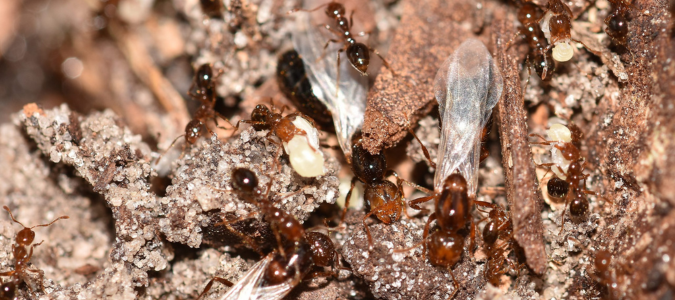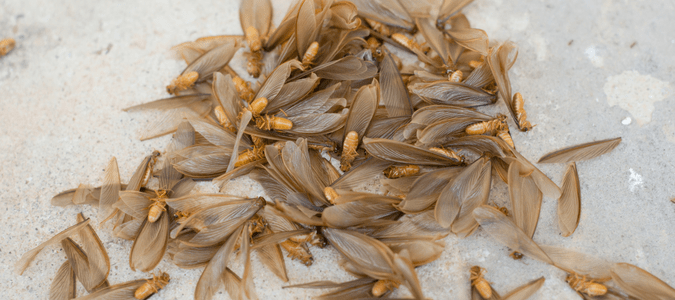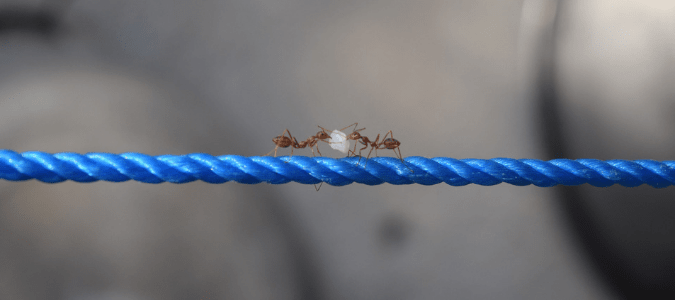Have you noticed small insects with wings around your property and wondered whether they are termites or fire ants?
Although distinguishing the two can be tricky, knowing which pest you are dealing with can help you better control them. If you’re dealing with any pest problems, contact a pest control professional. These experts have the knowledge and experience to tell the difference between flying fire ants, pictured above, and termites and can help you control both of these pests.
Flying Fire Ants
Flying fire ants are often known as reproductives, and they are the members of the colonies that reproduce and create new colonies. Unlike worker fire ants, who don’t have wings, reproductive flying ants’ wings allow them to move independently and take flight.
Appearance
Flying fire ants’ wings can extend twice the length of their bodies. Their body color is usually reddish-brown or dark brown. These insects possess segmented bodies with distinct head, thorax and abdomen regions, bent or elbowed antennae and sharp mandibles for defense.
Flying fire ants typically have larger bodies than worker ants, measuring between a quarter of an inch to three-eighths of an inch.
Behavior and Diet
Flying ants serve two main purposes: mating and colony formation. At certain points throughout the year, usually in late spring or early summer, fire ant colonies will produce winged males and females that become the basis of new colonies.
These fire ants with wings mate while flying, with males dying after mating with females. Those who successfully reproduce land safely on land to shed their wings.
Fire ants will then search for an ideal place to form their new colony, and once found, female fire ants burrow into the soil and start laying eggs, starting a brand new fire ant colony.
Flying fire ants consume similar diets as regular fire ants. They’re both omnivores that consume:
- Plant matter
- Seeds
- Fruit
- Sugary substances
- Pet food
Fire Ant Habitat
Fire ant populations thrive in warm, humid regions with plenty of food sources. These ants typically nest in well-drained soil, creating large mounds or nests easily identifiable as nests. Attracted by sunlight, flying fire ants often form colonies around rivers or ponds.
If you start noticing fire ant colonies popping up around your house, contact a pest control expert. Pest control specialists can create a custom treatment plan to get fire ants under control.
Termites
Termites often look similar to white ants. These insects live in large colonies with an organized social hierarchy. Each colony is comprised of different castes, such as reproductive swarmers, workers and soldiers. The workers’ and soldiers’ primary role is to establish new colonies.
While reproductive termites make sure that their species continues, workers are charged with foraging for food sources and building and maintaining nests to raise new termites. Soldiers have special adaptations like large jaws to defend the colony against any potential threats.
Termites play important environmental roles as decomposers, breaking down plant material and recycling nutrients into the earth.
However, their presence can cause significant structural damage since they consume wood that weakens buildings’ structural integrity over time.
Appearance
Termites are small insects with soft cylindrical bodies measuring around a quarter of an inch to half an inch long. They have six legs, two antennae and tend to be pale or light brown, though their appearance depends on their species and caste within their colony.
Soldier termites have larger heads with mandibles designed for defense and reproductive termites have two sets of wings.
Behavior and Diet
Termites communicate with each other by using chemical signals, pheromones and vibrations. These pests can cause extensive damage to homes, feeding on cellulose-rich materials such as wood, plants and dead plant matter.
Their digestive tract has special bacteria to break down this material into smaller bits that they digest easily. They use this ability to gain nutrients from plant material they ingest and consume other cellulose-rich waste like paper, cardboard and even fabrics.
Termites are likely to thrive and reproduce in habitats that have warm temperatures and ample humidity since moisture helps them thrive.
How To Tell Flying Fire Ants from Termites
Flying fire ants and termites may often be mistaken for one another. However, certain characteristics will help you distinguish them:
- Fire ants have segmented bodies with narrow waists, while termites feature more uniform cylindrical body types.
- Both fire ants and termites have wings, but they look very different. Termites have four wings that are equal in size, while flying fire ant wings can vary in size.
- Fire ants have elbowed antennae bent at 90-degree angles, while termites possess straight, bead-like antennae.
- Fire ants are typically reddish brown in color, while termites can range from light brown to white or even transparent.
- Fire ants are known for biting and stinging upon being disturbed. Termites typically avoid human interaction.
Both fire ants and termites can wreak havoc in your home, so it’s best to seek pest control professionals to identify and control termites and fire ants effectively.
Do Fire Ants Bite or Sting?
Many homeowners are surprised to learn that fire ants can both bite and sting. For their bite attack, flying fire ants use their mandibles, gripping tight onto skin with their clamped abdomen.
Many homeowners are surprised to learn that fire ants bite and sting you at the same time. First, they bite you using their mandible, gripping tight onto your skin and sticking its stinger into your skin, injecting venom. A fire ant bite may produce a burning sensation or result in the formation of a blister.
Some individuals can experience allergic reactions to fire ant bites that produce itching and hives. When dealing with fire ant stings, you should:
- Wash the area to reduce infection
- Apply a cold compress to alleviate the pain
- Avoid touching or scratching the bite or sting
- Keep an eye out for allergic reactions
Preventing fire ant bites starts with knowing how to identify a nest in your yard. Fire ants build colonies in the dirt outside that look like round piles of dirt. They often make them in the middle of a yard or field, but they can build them by the foundation of buildings. The best time to treat fire ants and their mounds is during spring or summer, after rain. A pest control professional can help you remove fire ants so you don’t have to worry about them.
Fire Ant Bites on Dogs
Unfortunately, fire ant bites on dogs are fairly common. If you notice fire ant bites on your dog, you should contact your vet and a pest control professional to keep any further bites or stings at bay.
So what should you do if your dog scratches at its fire ant bites?
- First, contact your veterinarian.
- Assess the severity of the bite(s). If the bites appear minor, you can manage them at home.
- If they become severe or your dog displays pain and discomfort, take them to the vet.
- Clean the affected areas to rid of any potential irritants and infection risks.
- Use pet-safe topical ointment or cream recommended by your veterinarian.
Prevent further bites by contacting a pest control expert that can control ants on your property.
The Bottom Line
Overall, it is key that you recognize flying termites versus fire ants around your home to address pest problems effectively. Understanding these pests’ physical characteristics and behavior allows you to take the measures necessary to protect your home and property. A pest control professional can effectively control flying fire ants and termites.
ABC Can Treat the Fire Ants on Your Property
Discovering a fire ant colony on your property is concerning for many reasons. Fortunately, ABC Home & Commercial Services can help. Our professionals will create a pest treatment plan that leaves you and your family feeling comfortable again. We can even help with other types of ants, like crazy ants.



